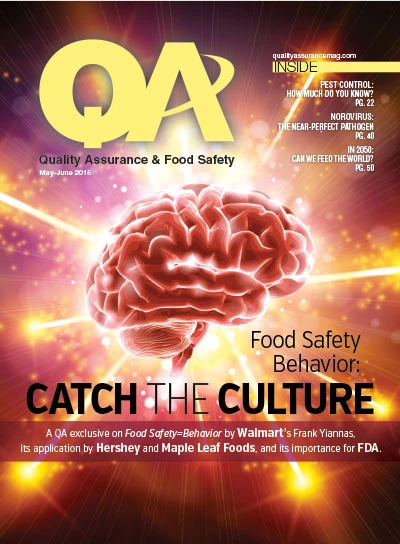 Lisa Lupo Lisa Lupo |
People will do what other people do. While there are always a few mavericks in any group, in most cases, people will follow the “social norm”—that is, the expected or standard behavior of a group in a given situation or environment. It is this concept that links together the “30 proven techniques to enhance employee compliance” of Walmart Vice President of Food Safety Frank Yiannas’ new book “Food Safety=Behavior”—which provides the foundation for this issue’s exclusive Special Report on Food Safety Culture. In fact, food safety culture is quickly becoming an industry buzz phrase. But, more importantly, it has been caught by leading companies and regulators, so as to be transitioning from a “nice to have” to a “required to have” either through regulatory focus (See FDA: Culture Is a Preventive Control, page 11) or your customers’ supplier standards (e.g., Hershey’s, Maple Leaf Foods, and Walmart, starting on page 12). As Yiannas states in the book’s Introduction, “As a food safety professional, getting others to comply with what you are asking them to do is critical, but it is not easy.” But it can be done, and in today’s world, it has to be done. With FSMA final rules just around the corner and judicial systems increasingly holding companies and executives liable for outbreaks, ensuring that everyone in your company is catching the food safety culture is just good business. So how is it done? Through the application of behavioral science principles to improve food safety. As Yiannas goes on to state, “One of the most exciting aspects of behavioral science research is that its results are often of simple and practical use to numerous professions, including ours—food safety.” Just one of these principles is that food safety may be catching (Chapter 18); that people will do what other people do. And when you take into consideration the three degrees of influence that can enable one person’s actions to ripple out from impacting immediate friends or associates to their friends/associates to their friends/associates, thousands of people (e.g., those in your company and up and down your supply chain) can be influenced by your attitude on food safety and demonstration of the right behaviors—to catch the food safety culture. As FDA Deputy Commissioner for Foods Michael Taylor said in a recent blog (http://1.usa.gov/1EjYg4V), ultimately, the only way we will achieve the goals that we are focused on “is if we have a system in which industry is systematically, every day, putting in place the measures that we know are effective in preventing contamination.” Are you building a food safety culture for your workers to catch onto—every day? Is your company’s “social norm” truly one of food safety? Are the people that others are emulating doing what needs to be done for food safety? What are your people doing that other people do?
The author is Editor of QA magazine. She can be reached at llupo@gie.net.
|

Explore the June 2015 Issue
Check out more from this issue and find your next story to read.
Latest from Quality Assurance & Food Safety
- Q&A: Sandra Eskin Leads Food Safety Advocacy Organization, STOP, as CEO
- STOP CEO Eskin on Government Layoffs, Challenges in Food Safety
- Mission Barns Announces Cell-Cultivated Pork Fat Launch Following FDA Clearance
- Hearthside Food Solutions Recalls Breakfast Sandwiches Due to Undeclared Allergen
- Walker’s Wine Juice Recalls Pumpkin Juice Due to Botulism Risk
- The Cascading Food Safety Impacts of Tariffs on the Food Industry
- Tyson Ventures Calls Startups to Apply for Tyson Demo Day
- Student Finalists Selected for IFT Product Development Competitions





